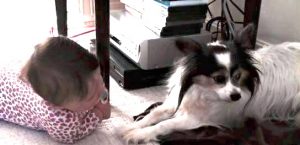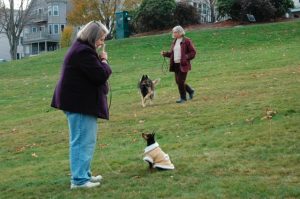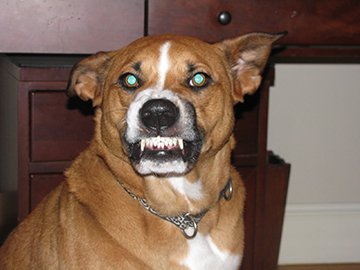Judy’s recipe to help you change the behavior of your territorial dog. These are dogs who rush and bark at people through windows, fences, and at the door.
- Management
- Understanding your dogs warning signals
- Training/Desensitization
- Proofing

1. Management means changing the environment so your dog is not put in situations that trigger his fear or pushes him over threshold. As any new negative experiences can make his fear worse. It also means preventing him from practicing unwanted behaviors so that they do not become a habit. Good management should be practiced while you train and desensitize your dog.
2. How to read your dog is an important step in changing his behavior. What are your dogs stress or warning signs? What signs does your dog use to tell strangers they would like to have more space? Have you observed your dog looking, or leaning away, growling, whale eye (whites of eye shows), head up with a frozen forward stance, air snapping, or barking at a person? If your dog is lunging at people, then you or a previous owner have missed his lower level warnings and allowed people to close, now he has to protect himself.

Learn your dogs stress signals, so you can support your dog. Low level distances cues should never be punished, as this can result in a dog that is not allowed to express his fear, hence he may bite with no warning.
Looking away from a person, turning muzzle away, turning neck farther away, closing the mouth, ears go back, brow may furrow, dog becomes still and possibly stiff, and the white of the eyes often appear. This is when YOU need to support your dog by calling them to safety or stepping in to reduce their stress. Remember, not all dogs have the same tolerance, your dog may wait three seconds before they bite when stressed while another dog may be more tolerant, waiting 10 seconds. Knowing your dog’s stress signals is essential to his or her success.

More serious distance cues are more obvious and may include growling, freezing, lip curling, show of teeth, air snapping, lunging and rapid barking, standing tall and motionless with direct eye contact. If a warning did not work, the dog may feel the need to bite to keep himself safe. If your dog skips this warning, it is possibly because he did not have time to give another warning or possibly your dog is not tolerant at all and will react much quicker as his nature.
3. Training or desensitizing and counter-conditioning (CC&D) is a wide spread behavior modification technique, whose ultimate goal is to change the emotional response (which leads to an overall change in the dog’s approach to the subject) towards a given “trigger” that caused the dog to react in the first place.
Counter conditioning is a classical conditioning approach where we pair something that created an unpleasant or scary response with something highly rewarding to the dog.
- If you use treats in various different exercises where your dog has no fear, then your dog most likely has a positive emotional response to the presence of treats which creates the opposite of a fear response.
- If at any time during your training, you dog stops eating, then slow the progression down, take a step back in your training. This is your dogs way of saying I am not comfortable with the current situation to eat.
By pairing food with a trigger at a sub-threshold distance (a distance where a dog has little or mild to no response) we are getting the “looking forward to” instead of the fearful aggressive response. Our goal is to change the emotional response towards something that was considered unpleasant to the dog before. Specifically, I use a process called Treat and Retreat https://caninebehaviorcounseling.com/regarding-that-dog-bite/
Using positive reinforcement training to teach your dog some emotional control can be very effective with territorial dogs. Teach your dog to sit and stay in different environments to help your dog see you as their leader. Any dog who has a good leader built on mutual trust will progress faster through this recipe. So be a good pack leader to your dog and ask many behaviors throughout each day and reward with food, toys or affection. These dogs are more likely to look to their leader for guidance when a guest arrives.

- Train a sit/stay while people pass on the street or local park, practicing so your dog can be successful is essential to your dogs success. Always begin each training session in an environment where your dog is calm and below threshold. Progress to environments closer to home, your street, driveway and in the home.
- Train a strong “come” or “here” to be able to call your dog away from a stranger when you see stress signals from your dog. Simply take some bits of cheese in your hand and say the cue word “here” when you dog looks at you, say “yes” and toss him a treat. Walk away and repeat “here” say “yes” as he begins to come to you and reward with five or six pieces! Practice in multiple situations and always be generous with the reward.
4. Proofing the behavior gives you the knowledge of how he will respond to a particular stimuli in different locations or situations. When I have proofed my dogs behavior in many different situations, I have verification or confirmation that I know how he is going to respond. If you are thinking your dog “reacts differently in different situations” than you need to slow your process down and get to know your dogs stress signals better. You are most likely missing some warning cues.
Keep in mind, every dog will progress at a different pace, this pace is set by the dog. Factors that effect how your dog responds can include many variables, such as how a person smells, moves, height, gender, if they make direct eye contact, are nervous, if they lean forward, or stomp their feet, how long they are near, just to name a few.
Remember, this is a recipe, if you leave out one ingredient, your final product will not be what you expected. All the ingredients must be included over a period of time. My wire haired terrier took over a

year to finally trust tall men and my scottie nearly double that time to trust any human, as she was five when I adopted her. She also came to me with an 8 bite history and two police reports in her file. Unfortunately, her previous trainer shocked her when she growled at people — yes, this did make her much worse. With Counter Conditioning how she felt about people, she began to see them as a predictor of good things and safety. You can imagine how gratifying it was when she passed her Canine Good Citizen Certification by a trainer she had never met before. Parenting a territorial dog is a process, stay positive and celebrate the small successes with your dog.


